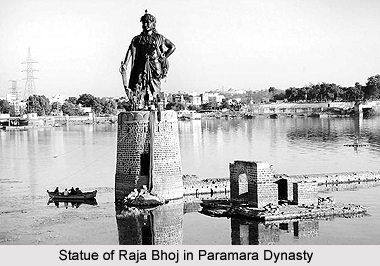 History of Dewas District broadly corresponds to the twin treaty states of the senior and junior branch of Madhya Bharat States of the early twentieth century with some adjustments of other territories. History of Dewas District also states that there were two district chief ships with separate administrations, acting independently in most matters, sharing the same capital town of Dewas. Consequent upon the merger of princely states and the formation of Madhya Bharat State in the year 1948 there was reconstitution of boundaries and thus the district in the present form was constituted.
History of Dewas District broadly corresponds to the twin treaty states of the senior and junior branch of Madhya Bharat States of the early twentieth century with some adjustments of other territories. History of Dewas District also states that there were two district chief ships with separate administrations, acting independently in most matters, sharing the same capital town of Dewas. Consequent upon the merger of princely states and the formation of Madhya Bharat State in the year 1948 there was reconstitution of boundaries and thus the district in the present form was constituted.
According to the history of Dewas District, the reconstituted district of Dewas was, however, formed by merging 242 villages. These are the accumulation of two Tehsils of Dewas of the former Senior and Junior State, 452 villages of Sonkatch tehsil and 99 villages of Ujjain tehsil of former Gwalior state, 99 villages of Nimanpur tehsil, of Dhar District, one village of Jawar tehsil of former Bhopal state, and then the existing tehsils of Kannod and Khategaon of former Holkar State. With the reorganisation of states on linguistic basis on 1st of November, 1956, Madhya Bharat, with other territories got merged to form the new state of Madhya Pradesh and thus Dewas District continues to be one of the districts in it.
The founder of the Senior Branch of Dewas was Tukoji Rao (I), a descendant of the old Paramara dynasty. He died in the year 1753 and was succeeded by his adopted son Krishnaji Rao. The fortunes of both the branches fell very low at this time owing to the depredations of the Pindaris, Sindhia and Holkar, Krishnaji Rao II, who succeeded Rukmangad Rao in the year 1860 by adoption. He was a bad administrator and plunged the state in debt. Later, Tukoji Rao III who was adopted from another branch of the family flourished Dewas District in agricultural perspective.
History of Dewas District also says that Dewas played an important role in the Sepoy Mutiny 1857. Thakur Dowlat Singh of Raghogarh (Dewas) faced the British East India Company with supreme courage. He was trapped, arrested and hanged in Guna Cantonment. Both these states were merged in to Madhya Bharat in 1948. According to historical accounts, the other important constituent of the district is Nemawar consisting of Kannod and Khategaon tehsils of former Holkar state. In Puranic literature, Nemawar is spoken of as Nabhapur and the hillock nearby now called `Gwal Tekri` is mentioned there in as Mani Gir.
During the reign of the Mughal Emperor Akbar, this tract was included under the name Nemawar Panch Mahal in Sarkar Handia of the Subah of Malwa and comprised the five Parganas of Nemawar, Satwas, Rajor, Kataphor and Harangaon, the first three being the headquarters of Mahals. This area passed over to the Peshwas in between 1740 - 1745 and was divided between Scindhia and Holkar, the former acquiring Satwas and the latter Kataphor. Pindaris had also a hold on this territory near about 1806. In 1904, Harangaon was merged in to Nemawar and Satwas with Kataphor. In 1908, Nemawar was renamed. Khategaon and Rajor was named as Kannod. Kataphor was then merged with Kannod.
Dewas tehsil consisted of the home blocks of Dewas senior and Dewas junior excluding Khankhera and Umsod villages of the former and villages Goyta, Tanda and Gujarbardia of the latter, with were joined with Shajapur tehsil. Sonkatch tehsil consisted of all the villages of the Sonkatch Pargana excluding 200 villages included in Bagli Tehsil and 26 villages were joined with Shajapur. Bagli tehsil was formed with the merger of 200 villages of Sonkatch Pargana and two villages (Shivpur Mandia and Borkheda Purbya) of Dewas senior with the Nimanpur Pargana of the erstwhile Dhar state. There was no change whatsoever in Kannod and Khategaon Tehsils of Nemawar district of former Holkar state.






